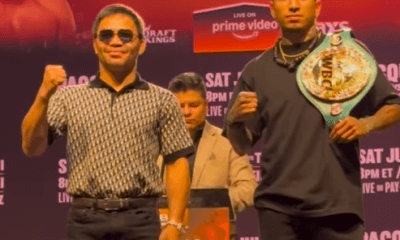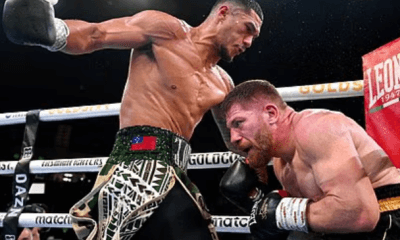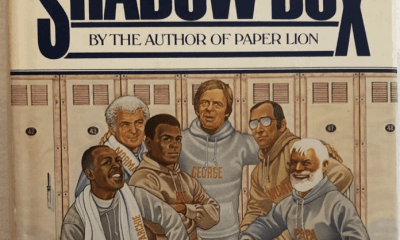Featured Articles
Dmitry Mikhaylenko and Manuel Avila Win Titles in Indio
INDIO, CALIF.-It was international night as Russia’s Dmitry Mikhaylenko stopped Venezuela’s Johan Perez by knockout to win the vacant NABA welterweight title on Saturday evening.
Mikhaylenko (20-0, 9 Kos) was venturing to welterweight and dominated Perez (20-3-1, 13 Kos) with his awkward but pressuring style that kept fans entertained at the Fantasy Springs Casino. It was the Russian fighter’s first fight on the West Coast.
The move to welterweight was no problem for Mikhaylenko.
“I didn’t feel anything that felt hard in this weight,” he said.
From the opening bell Mikhaylenko was able to do whatever he pleased against the veteran slugger from Venezuela. It wasn’t until Perez switched to southpaw that Mikhaylenko had problems. But only for a round. After that, the Russian fighter adjusted and kept the pressure on Perez.
In round eight Mikhaylenko staggered Perez around the ring and connected with a dozen unanswered blows. The referee asked the Venezuelan if he was OK and he nodded yes. Mikhaylenko connected with six more blows and referee Ray Corona wisely stopped the fight at 1:21 of the round for a technical knockout victory for Mikhaylenko.
In the semi-main event Manuel Avila (18-0, 8 Kos) used his left jab and perfect right counters to keep Cuba’s Yoandris Salinas (21-2-2, 14 Kos) off balance and tentative for the first round.
Salinas tried to work his way in and was caught with a flush counter right and down he went in the second round. He seemed stunned as Avila moved in for the kill. The Cuban fighter held and moved away to get his senses and made it out of the round.
Avila looked anxious to get the knockout and walked into a perfect right hand blast to the chin from Salinas. He didn’t seem hurt and kept moving in but more cautiously.
From the fourth round on it became a chess match as both tried setting up their knockout blows. Salinas would land another but after that it was all Avila. Triple jabs and double hooks from Avila kept Salinas from setting any traps and at the end of round six the Cuban fighter said he could not continue due to an injured right hand. Avila wins the interim NABF super bantamweight title.
Philadelphia’s Tevin Farmer (20-4-1, 5 Kos) ran over Colombia’s Daulis Prescott (29-3, 22 Kos) in a super featherweight bout. The left-handed Farmer was too fast and too clever for Prescott who showed guts hanging in there but his corner should have stopped the fight in round five.
Instead Prescott took a whipping that ended with a left cross to the jaw at 52 seconds of round eight for a knockout victory. Farmer was in control the entire fight.
The very unimposing Joet Gonzalez (11-0, 5 Kos) stepped in the ring against Mexican veteran Miguel Tamayo and quickly set the tempo with a right to the side of the head that staggered his opponent. Gonzalez cornered his foe and unloaded 20 consecutive unanswered blows. Tamayo survived. Two rounds later Gonzalez worked the body and landed left to the body the sunk Tamayo. He got up but another left hook to the body collapsed Tamayo and this time for good at 2:17 of round three. Gonzalez looked pretty potent.
“This fight was originally was supposed to be scheduled for eight-rounds but the commission only approved six but I feel like this win really proved that I am ready to go more rounds,” Gonzalez said. “I have great training and know that great things are coming for me.”
Ireland’s Jason Quigley (8-0, 8 Kos) was a late addition to the fight card but no sign of rustiness or unpreparedness showed in his demolition of New York City’s southpaw Michael Faulk (3-3).
Quigley stalked Faulk immediately at the opening bell and focused on the body. The New York City fighter was very tentative about firing any punches. Instead he covered and moved from Quigley’s firing range.
In the second round Faulk decided to exchange with Quigley and ran into a right cross to the chin. Down he went. Faulk beat the count and was met with another flush right and went down once more. Faulk got up and Quigley put him down for good with a crunching left hook. A towel was thrown in the ring from Faulks corner and the fight ended at 2:59 of the third round.
“It feels so great to add another victory to my record and the fact that it was another knockout makes me feel like bigger and better things will be coming my way. But we have to take it one step at a time, these fights are all stepping stones to a future title match. I am still learning, still climbing the latter, but I know that very soon I will get my chance to be a world champion,” Quigley said.
Neeco Macias out-slugged Julian Cruz after six rounds of a junior middleweight scrap. All three judges gave it to Macias at 60-54 twice and 59-55.
-

 Featured Articles3 weeks ago
Featured Articles3 weeks agoAvila Perspective, Chap. 330: Matchroom in New York plus the Latest on Canelo-Crawford
-

 Featured Articles2 weeks ago
Featured Articles2 weeks agoVito Mielnicki Jr Whitewashes Kamil Gardzielik Before the Home Folks in Newark
-

 Featured Articles4 weeks ago
Featured Articles4 weeks agoAvila Perspective, Chap 329: Pacquiao is Back, Fabio in England and More
-

 Featured Articles4 weeks ago
Featured Articles4 weeks agoOpetaia and Nakatani Crush Overmatched Foes, Capping Off a Wild Boxing Weekend
-

 Featured Articles3 weeks ago
Featured Articles3 weeks agoCatching Up with Clay Moyle Who Talks About His Massive Collection of Boxing Books
-

 Featured Articles4 weeks ago
Featured Articles4 weeks agoFabio Wardley Comes from Behind to KO Justis Huni
-

 Featured Articles1 week ago
Featured Articles1 week agoMore Medals for Hawaii’s Patricio Family at the USA Boxing Summer Festival
-

 Featured Articles4 weeks ago
Featured Articles4 weeks agoDelving into ‘Hoopla’ with Notes on Books by George Plimpton and Joyce Carol Oates
















